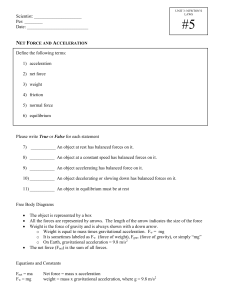

Since this impulse is "resistive" in nature, it will decrease the object's momentum by 48 units. This is equivalent to an impulse of 48 units (N The object then encounters a resistive force of 6.0 N for 8.0 s. If the impulse is in the direction of an object's motion, then it will increase the momentum. A 60-unit impulse will change the momentum by 60 units, either increasing or decreasing it. It then encounters an impulse of 60 units (N This question is best thought about conceptually using the principle that an objects momentum is changed when it encounters an impulse and the amount of change in momentum is equal to the impulse which it encounters. Determine the final velocity of the object. A resistive force of 6.0 N then impedes its motion for 8.0 seconds. s impulse acts upon it in the direction of motion for 5.0 seconds.A 4.0-kg object has a forward momentum of 20. So if impulse is known and time is known, force can be easily determined.į = Impulse/t = (-16.7 N s) / (0.100 s) = -167 Nĥ8. (b) The impulse is the product of force and time. Where the "-" indicates that the impulse was opposite the original direction of motion. (a) determine the impulse with the wall, (b) determine the force of the wall on the ball.Īnswer: Answer: (a) -16.7 N s (b) -167 N A 0.530-kg basketball hits a wall head-on with a forward speed of 18.0 m/s. Momentum and Collisions - Home || Printable Version || Questions with LinksĪnswers to Questions: All || #1-5 || #6-36 || #37-56 || 57-72ĥ7.

What was the average force on the ball while it was in contact with the floor? FΔt = mΔv F = (mΔv)/ Δt (0.045kg)(8.94m/s)/(4.0x10-4s) = 1005.The Review Session » Momentum and Collisions » Answers Q#57-72 Momentum and Collisions Review Suppose that the golf ball was in contact with the floor for 4.0 x 10-4s. What will be the change in momentum, (p) from the instant before the ball collides with the floor until the instant after it rebounds from the floor? (Illustrate with a vector diagram.) Δρ = (0.045 kg)(4.47m/s-(-4.47m/s)) = 0.4023 kg-m/s e. What will the instantaneous momentum of the golf ball be immediately before it strikes the floor? vf = at + vi vf = 10m/s2*0.45s = 4.47m/s 0.045kg(4.47m/s) = 0.20 kg-m/s d. Determine the time required for the ball to reach the floor. In the margin, construct a motion map for the golf ball from the time it is dropped until it reaches its highest point of rebound. Assume that the golf ball has a perfectly elastic collision with the floor. How long must the engine burn in order to reach this speed?įΔt = mΔv 104 N) Δt = 4.36 x 103 N*860m/s Δt = 4.43sĪ golf ball that weighs 0.45 N is dropped from a height of 1.0 m. Draw a force diagram for the rocket.įg b. A rocket, weighing 4.36 x 104 N, has an engine that provides an upward force of 8.90 x 105 N. What force does the ball exert on the bat in the question above? Explain. What is the change in momentum of the ball? What is the final velocity of the ball? (use initial velocity from #4) FΔt = impulse = momentum = mΔv 1320N*(9.0x10-3 s) = 11.88 N-s = (0.140kg)Δv Δv = 84.9 m/s = vf –vi = 84.9m/s = vf – (- 42.4m/s) = + 42.5 m/s 6. When the batter hits the ball, a net force of 1320 N, opposite to the direction of the ball's initial motion, acts on the ball for 9.0 x 10-3 s during the hit. If the initial speed of the baseball in question 3 is v0 = 0.0 m/s, what will its speed be when it leaves the pitcher's hand? FΔt = impulse = momentum = mΔv 132N*(4.5x10-2 s) = 5.94 N-s = (0.140kg)Δv Δv = 42.4 m/s 5. What is the magnitude of the change in momentum of the ball? FΔt = impulse = momentum = mΔv 132N*(4.5x10-2 s) = 5.94 N-sĤ. While being thrown, a net force of 132 N acts on a baseball (mass = 140g) for a period of 4.5 x 10-2 sec. Object C has twice the velocity of object D. Two other objects, C and D, have identical masses. Object A has 3 times the mass of object B.

Two objects, A & B, have identical velocities.


 0 kommentar(er)
0 kommentar(er)
